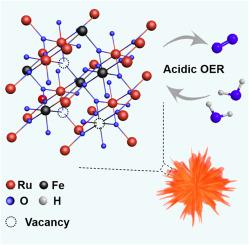Nano Energy ( IF 17.6 ) Pub Date : 2021-02-21 , DOI: 10.1016/j.nanoen.2021.105909 Qing Yao , Bolong Huang , Yong Xu , Leigang Li , Qi Shao , Xiaoqing Huang

|
RuO2-based catalysts have been widely used for acidic oxygen evolution reaction (OER), a key half reaction of overall water splitting. However, RuO2 suffers from the drawbacks of inferior OER performance in acidic conditions due to its poor stability. We here demonstrate a chemical etching strategy for fabricating a Ru/Fe oxide towards OER, in which Fe species in the pristine Ru/Fe nanoassemblies (P-Ru/Fe NAs) are partially etched by nitric acid (HNO3), leading to the generation of abundant vacancies in the etched Ru/Fe oxide nanoassemblies (E-Ru/Fe ONAs). Owing to the etching of Fe, the local electron density of the lattice O associated with Ru atoms is significantly increased, resulting in the suppression of H2O adsorption on lattice O. On the other hand, the O vacancies in the E-Ru/Fe ONAs can promote the H2O adsorption on metal atoms (i.e., Ru and Fe). Consequently, the optimized E-Ru/Fe ONAs exhibit a superior OER activity with a low overpotential of 238 mV at 10 mA cm−2 in 0.5 M H2SO4, and an enhanced stability with a negligible potential change within 9 h chronopotentiometry test. Theoretical calculations demonstrate that the defective surface of E-Ru/Fe ONA can not only enhance the stability via surface structural modulation, but also optimize the binding strength of the intermediates for promoting OER activity. This work provides an efficient strategy for fabricating active and stable RuO2-based catalysts for OER, which may deepen the research in surface engineering of catalysts.
中文翻译:

一种化学蚀刻策略,用于改善和稳定基于RuO 2的纳米组件以释放酸性氧
基于RuO 2的催化剂已被广泛用于酸性氧气释放反应(OER),这是整个水分解的关键半反应。但是,RuO 2的稳定性差,因此在酸性条件下具有OER性能差的缺点。我们在这里展示了一种针对OER制造Ru / Fe氧化物的化学蚀刻策略,其中原始Ru / Fe纳米组件(P-Ru / Fe NAs)中的Fe物种被硝酸(HNO 3)部分蚀刻,从而导致蚀刻的Ru / Fe氧化物纳米组件(E-Ru / Fe ONAs)中产生大量空位。由于Fe的蚀刻,与Ru原子相关的晶格O的局部电子密度显着增加,从而抑制了H 2。O在晶格O上的吸附。另一方面,E-Ru / Fe ONAs中的O空位可以促进H 2 O在金属原子(即Ru和Fe)上的吸附。因此,优化的E-Ru / Fe ONA表现出优异的OER活性,在0.5 M H 2 SO 4中在10 mA cm -2下具有238 mV的低过电势,并且在9 h计时电位测试中具有增强的稳定性,且电势变化可忽略不计。理论计算表明,E-Ru / Fe ONA的缺陷表面不仅可以通过表面结构调节提高稳定性,而且可以优化中间体的结合强度以促进OER活性。这项工作为制造活性和稳定的RuO 2提供了有效的策略。催化剂用于OER,这可能会加深催化剂表面工程的研究。


























 京公网安备 11010802027423号
京公网安备 11010802027423号